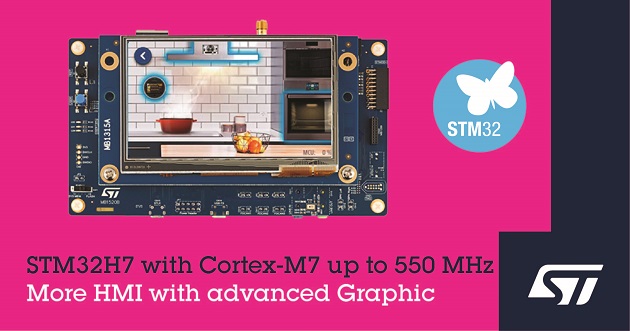STMicroelectronics (NYSE: STM), a global semiconductor leader serving customers across the spectrum of electronics applications, has revealed record-breaking STM32* microcontrollers (MCUs) with embedded Flash that bring high-end features such as rich graphics, AI, and state-of-the-art cyber-protection to cost-sensitive new products.
The new STM32H7 MCUs build on the Arm® Cortex®-M7 core and operate at 550 MHz, the fastest core speed in the market among MCUs that integrate Flash storage on-chip to run deeply embedded applications. These single-core devices, which are available with up to 1 Mbyte of Flash, deliver increased performance with affordability for cost-conscious applications.
At the same time, the devices can interact with off-chip storage while ensuring full execution performance and security. Their benchmark performance figures of 2778 CoreMark®1 and 1177 DMIPS are realized whether working from internal or external memory, aided by features such as the Flexible Memory Controller (FMC) and Octal SPI memory interface. This lets designers tackle memory-hungry applications, such as high-resolution, full-color graphics and video that demand a large frame buffer, to create new products that deliver more sophisticated and immersive user experiences.
Further assisting the creation of full-color user interfaces, the TouchGFX graphic framework STM32Cube Expansion Package (X-CUBE-TOUCHGFX) and TouchGFX Designer programming tool are available free of charge.
Advanced features powered by AI technology can be developed thanks to STM32Cube ecosystem and STM32Cube.AI (X-CUBE-AI) to port neural networks and leverage computer vision through the parallel camera interface. By connecting the STM32H7 to one or multiple sensors, condition monitoring and other machine learning techniques will also help bringing added value to the STM32-based product.
As part of the STM32Trust security suite, cyber-protection is enhanced with support for on-the-fly decryption (OTFDEC) and secure firmware install (SFI). OTFDEC enables encrypted code to be executed from external memory. SFI lets OEMs order standard products anywhere in the world, to be programmed only with encrypted code. These two solutions effectively safeguard OEM intellectual property in Flash memory. Out-of-the-box security features include support for secure boot, symmetric (by hardware or software library) encryption, and cryptographic key provisioning. Asymmetric encryption (by software library) is also available. Cryptographic processing is handled with a true random number generator, hardware acceleration for AES-128, AES-192 and AES-256 encryption, and support for GCM and CCM2, Triple DES, and hash (MD5, SHA-1 and SHA-2) algorithms.
“Our latest STM32H7 MCUs enable small, low-power products to deliver extraordinary functionality and performance, while leveraging the outstanding value and efficiency of the STM32 family,” said Ricardo de Sa Earp, Group Vice President, Microcontroller Division General Manager, STMicroelectronics. “Home appliances, small medical devices, and industrial sensors and actuators that might previously have been unable to incorporate computationally intensive features such as AI, graphics, and voice interaction now have an appropriate solution.”
Several key features deliver important advantages in industrial applications, including an integrated switched-mode power supply (SMPS) that overcomes dissipation constraints to allow extended-temperature operation up to 125°C. In addition, fault-resilience is provided through error correction (ECC) for all memories.
ST has updated the STM32 development ecosystem to let users get started quickly with the new devices. Flexible prototyping and demonstrations can leverage the STM32H735G-DK Discovery kit, while the NUCLEO-H723ZG Nucleo-144 board provides an affordable option for quickly building prototypes and proof-of-concept models. The latest STM32H7 MCUs are also supported in the STM32Cube ecosystem, which comprises tools, embedded software, and middleware including graphics libraries, communication stacks, and application-code examples such as motor control, AI, and advanced security.
The MCUs’ capabilities can also be exercised using appropriate software tools for application and security development published by Arm® Keil and IAR Systems.
Haydn Povey, General Manager Embedded Security Solutions, IAR Systems, commented: “ST’s latest STM32H7 MCUs deliver game-changing value, performance and security enhancements. The security features, including enhanced cryptographic accelerators, advanced off-chip memory protection, and secure key provisioning are all critical capabilities in achieving legislative requirements, including the recent EN303645 standard. We expect IAR Embedded Workbench, coupled with C-Trust for security, to be the IDE of choice for engineers to realize their full potential in next-generation designs.”
The new STM32H7 devices introduced are the STM32H723/733, STM32H725/
* STM32 is a registered and/or unregistered trademark of STMicroelectronics International NV or its affiliates in the EU and/or elsewhere. In particular, STM32 is registered in the US Patent and Trademark Office.
Further technical information:
Each of the new devices is based on the Arm Cortex-M7 core running at the record-breaking frequency of 550 MHz and features single-core architecture to deliver cost-effective advanced performance. Further features that let designers maximize performance, energy efficiency, and flexibility in diverse applications include:
·32 Kbytes I-cache and D-cache sizes
·Tightly coupled instruction RAM (ITCRAM) with remapping for zero latency in time-critical routines
·ST’s proven FMAC (filtering) and Cordic (trigonometric) blocks for mathematical acceleration
·Crypto algorithms supported
·Advanced analog peripherals including two 16-bit ADCs and one 12-bit ADC in the low-power domain
·Interfaces to popular industrial connectivity standards, including three
FD-CAN ports, Ethernet, and Parallel Synchronous Slave Interface (PSSI)
·ST’s Chrom-ART Accelerator™ for superior graphics performance
For more information, visit blog.st.com

